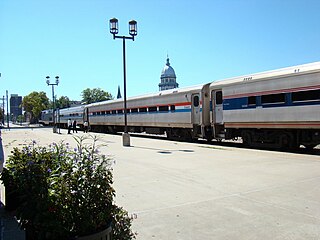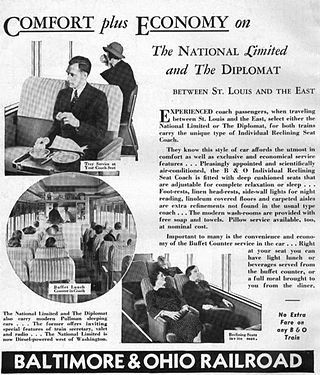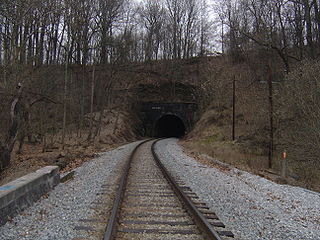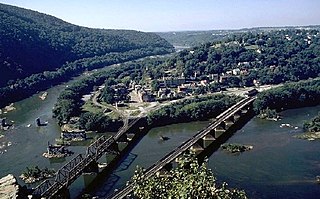
The Ann Rutledge was a passenger train service operated by Amtrak running between St. Louis, Missouri, and Kansas City, Missouri, as part of the Missouri Services brand. In 2009 Amtrak consolidated the Ann Rutledge, Kansas City Mule, and the St. Louis Mule under the new name Missouri River Runner.

The Capital Subdivision is a railroad line owned and operated by CSX Transportation in the U.S. state of Maryland and the District of Columbia. The line runs from near Baltimore, Maryland, southwest to Washington, D.C., along the former Baltimore and Ohio Rail Road (B&O) Washington Branch. The subdivision's Alexandria Extension provides a connection to Virginia and points south.

The B&O Warehouse is a building in Baltimore, Maryland, adjacent to Oriole Park at Camden Yards. It was constructed by the Baltimore and Ohio Railroad (B&O) beginning in 1899, with later sections completed in 1905, adjacent to the B&O's Camden Station and Freight Yard, which was located at the corner of Camden St and Eutaw St.

The Dalecarlia Tunnel in Brookmont, Maryland, near Washington, D.C. is a former railroad tunnel that presently carries the Capital Crescent Trail underneath MacArthur Boulevard and the Washington Aqueduct.

The Columbian was a named passenger train operated by the Baltimore and Ohio Railroad. It was the all-coach supplemental train of the all-Pullman Capitol Limited. It operated from 1931 to 1964. The train's initial route was between Jersey City, New Jersey and Washington, D.C., but in 1941 the Columbian route was lengthened to Jersey City – Chicago, Illinois. It was the first air-conditioned train in the United States.

The Frederick Branch is a railroad line in Frederick County, Maryland. It was built by the Baltimore and Ohio Railroad (B&O) in 1831, and is now owned by the Maryland Department of Transportation (MDOT). The 3.4 mi (5.5 km) branch extends between Frederick Junction – a wye with the Old Main Line Subdivision of CSX Transportation on the west side of the Monocacy River – and its terminus at East Street in downtown Frederick, Maryland. The wye at Frederick Junction was the first example of its kind in the United States and is still in use today.

The National Limited was the premier train of the Baltimore and Ohio Railroad (B&O) on its route between Jersey City, New Jersey and St. Louis, Missouri, with major station stops in Washington, D.C., and Cincinnati, Ohio. It operated from 1925 to 1971. For much of its life it offered exclusive all-Pullman service, and it was the first long-distance train to be entirely air-conditioned. The National Limited was one of many trains discontinued when Amtrak began operations on May 1, 1971. Amtrak revived the name for another New York–St. Louis service which did not use the B&O route.
Jonathan Knight was an American politician who served as an Opposition Party member of the U.S. House of Representatives for Pennsylvania's 20th congressional district from 1855 to 1857. He also served as a member of the Pennsylvania Senate for the 20th district from 1822 to 1828. He was a civil engineer who worked on the National Road and as the first chief engineer of B&O Railroad.

The President Street Station in Baltimore, Maryland, is a former train station and railroad terminal. Built in 1849 and opened in February 1850, the station saw some of the earliest bloodshed of the American Civil War (1861-1865), and was an important rail link during the conflict. Today, it is the oldest surviving big-city railroad terminal in the United States. A preservation campaign and renovation project completed in 1997 enabled the station to be operated as the Baltimore Civil War Museum for several years.

The Philadelphia Subdivision is a railroad line owned and operated by CSX Transportation in the U.S. states of Pennsylvania, Delaware, and Maryland. The line runs from Philadelphia, Pennsylvania, southwest to Baltimore, Maryland, along a former Baltimore and Ohio Railroad (B&O) line.

Philip Evan Thomas was the first president of the Baltimore and Ohio Railroad (B&O) from 1827 to 1836. He has been referred to as "The Father of American Railways". The Thomas Viaduct bridge in Relay, Maryland, was named after him.

The Royal Blue was the Baltimore and Ohio Railroad (B&O)'s flagship passenger train between New York City and Washington, D.C., in the United States, beginning in 1890. The Baltimore-based B&O also used the name between 1890 and 1917 for its improved passenger service between New York and Washington, collectively dubbed the Royal Blue Line. Using variants such as the Royal Limited and Royal Special for individual Royal Blue trains, the B&O operated the service in partnership with the Reading Railroad and the Central Railroad of New Jersey. Principal intermediate cities served were Philadelphia, Wilmington, and Baltimore. Later, as Europe reeled from the carnage of World War I and connotations of European royalty fell into disfavor, the B&O discreetly omitted the sobriquet Royal Blue Line from its New York passenger service and the Royal Blue disappeared from B&O timetables. Beginning in 1917, former Royal Blue Line trains were renamed: the Royal Limited, for example, became the National Limited, continuing west from Washington to St. Louis via Cincinnati. During the Depression, the B&O hearkened back to the halcyon pre-World War I era when it launched a re-christened Royal Blue train between New York and Washington in 1935. The B&O finally discontinued all passenger service north of Baltimore on April 26, 1958, including the Royal Blue.

The Diplomat was a named passenger train of the Baltimore and Ohio Railroad (B&O) during the 1930s–1950s connecting New York City and St. Louis, Missouri, via Washington, D.C. Other B&O trains on the route during that period were the premier National Limited and the workhorse Metropolitan Special. The train was inaugurated in August 1930 after several changes to trains along the St. Louis Route. After World War II, the Diplomat operated as Train No. 3 westbound, and No. 4 eastbound. It was timed to provide connections to several western railroads that terminated in St. Louis, including the Frisco, the Santa Fe, Cotton Belt and Missouri Pacific, among others.

The Henryton Tunnel, located near Henryton in southern Carroll County, Maryland, is the third-oldest tunnel in the world that remains in active railroad use. Constructed by the Baltimore and Ohio (B&O) Railroad and opened around 1850, it was the first tunnel constructed on the B&O's Old Main Line. In 1865 the tunnel was widened to accommodate double track. It was rebuilt into its current form in 1903. The tunnel has brick portals and lining. The coping and footings are concrete.

The Baltimore and Ohio Ellicott City Station Museum in Ellicott City, Maryland, is the oldest remaining passenger railway station in the United States, and one of the oldest in the world. It was built in 1830 as the terminus of the Baltimore and Ohio Railroad line from Baltimore to the town then called Ellicott's Mills, and a facility to service steam locomotives at the end of the 13-mile (21 km) run. The station, a National Historic Landmark, is now used as a museum.

The B & O Railroad Potomac River Crossing is a 15-acre (6.1 ha) historic site where a set of railroad bridges, originally built by the Baltimore and Ohio Railroad, span the Potomac River between Sandy Hook, Maryland and Harpers Ferry, West Virginia. The site was added to the National Register of Historic Places on February 14, 1978 for its significance in commerce, engineering, industry, invention, and transportation.

The Mount Clare Shops is the oldest railroad manufacturing complex in the United States, located in Baltimore, Maryland. It was founded by the Baltimore and Ohio Railroad (B&O) in 1829. Mt. Clare was the site of many inventions and innovations in railroad technology. It is now the site of the B&O Railroad Museum. The museum and Mt. Clare station were designated a National Historic Landmark in 1961.

Silver Spring station is a former train station on the Metropolitan Subdivision in Silver Spring in Montgomery County, Maryland. It was built in 1945 by the Baltimore and Ohio Railroad on the foundation of a previous station, a Victorian-style brick structure built in 1878. It served intercity trains until 1986 and light rail until 2000. Today, it is owned and operated as a museum by Montgomery Preservation, Inc., a non-profit organization.

The Baltimore Terminal Subdivision is a railroad line owned and operated by CSX Transportation in the U.S. state of Maryland. The line runs from Baltimore to Halethorpe along the original Baltimore and Ohio Railroad (B&O) line, one of the oldest rail lines in the United States and the first passenger railroad line. At its east (north) end, it connects with the Philadelphia Subdivision; its west (south) end has a junction with the Capital Subdivision and the Old Main Line Subdivision.

The Metropolitan Railroad was a 19th-century Maryland corporation that proposed to build a railroad line from Washington, D.C., to the vicinity of Frederick, Maryland, where it would connect with the Baltimore and Ohio Railroad (B&O), and continue to Hagerstown. The company was organized by businessmen from Washington and Montgomery County, Maryland, and was chartered by the Maryland General Assembly in 1853. It conducted some initial land surveys, but had difficulty raising funds and went bankrupt in 1863. The B&O subsequently constructed a rail line on a similar route, and opened its Metropolitan Branch in 1873.


















